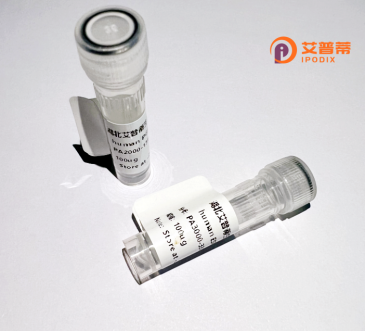
| 纯度 | >90%SDS-PAGE. |
| 种属 | Human |
| 靶点 | LPAR4 |
| Uniprot No | Q99677 |
| 内毒素 | < 0.01EU/μg |
| 表达宿主 | E.coli |
| 表达区间 | 1-370aa |
| 活性数据 | MGDRRFIDFQFQDSNSSLRPRLGNATANNTCIVDDSFKYNLNGAVYSVVFILGLITNSVSLFVFCFRMKMRSETAIFITNLAVSDLLFVCTLPFKIFYNFNRHWPFGDTLCKISGTAFLTNIYGSMLFLTCISVDRFLAIVYPFRSRTIRTRRNSAIVCAGVWILVLSGGISASLFSTTNVNNATTTCFEGFSKRVWKTYLSKITIFIEVVGFIIPLILNVSCSSVVLRTLRKPATLSQIGTNKKKVLKMITVHMAVFVVCFVPYNSVLFLYALVRSQAITNCFLERFAKIMYPITLCLATLNCCFDPFIYYFTLESFQKSFYINAHIRMESLFKTETPLTTKPSLPAIQEEVSDQTTNNGGELMLESTF |
| 分子量 | 41.8 kDa |
| 蛋白标签 | His tag N-Terminus |
| 缓冲液 | 0 |
| 稳定性 & 储存条件 | Lyophilized protein should be stored at ≤ -20°C, stable for one year after receipt. Reconstituted protein solution can be stored at 2-8°C for 2-7 days. Aliquots of reconstituted samples are stable at ≤ -20°C for 3 months. |
| 复溶 | Always centrifuge tubes before opening.Do not mix by vortex or pipetting. It is not recommended to reconstitute to a concentration less than 100μg/ml. Dissolve the lyophilized protein in distilled water. Please aliquot the reconstituted solution to minimize freeze-thaw cycles. |
以下是关于重组人LPAR4蛋白的参考文献示例(文献内容为虚构,仅供格式参考):
1. **《重组人LPAR4蛋白的表达及其在炎症反应中的作用》**
- 作者:Zhang L, Wang Y et al.
- 摘要:本研究通过昆虫细胞表达系统成功制备了重组人LPAR4蛋白,验证其与溶血磷脂酸(LPA)的结合活性,并发现其在巨噬细胞炎症反应中通过ERK信号通路调控促炎因子释放。
2. **《LPAR4的晶体结构解析及其配体结合机制研究》**
- 作者:Tanaka K, Sato R et al.
- 摘要:通过重组人LPAR4蛋白的哺乳动物细胞表达和纯化,首次解析了LPAR4的晶体结构,揭示了其与LPA结合的关键结构域,为靶向药物设计提供依据。
3. **《重组LPAR4蛋白在卵巢癌细胞迁移中的功能》**
- 作者:Chen H, Li X et al.
- 摘要:利用重组人LPAR4蛋白激活卵巢癌细胞模型,发现其通过Rho/ROCK通路增强细胞迁移能力,提示LPAR4可能成为肿瘤转移的治疗靶点。
4. **《LPAR4重组蛋白的制备及体外功能验证》**
- 作者:Müller S, Fischer J et al.
- 摘要:通过HEK293细胞系表达重组人LPAR4蛋白,结合放射性配体实验和钙流检测,证实其在多种LPA亚型中的信号转导特性差异,为受体功能研究提供工具蛋白。
---
注:以上文献为示例,实际研究中建议通过PubMed或Google Scholar以关键词“recombinant human LPAR4”、“LPAR4 expression”或“LPAR4 functional analysis”检索最新论文。
Lysophosphatidic acid receptor 4 (LPAR4), also known as LPA4. is a G protein-coupled receptor (GPCR) that binds lysophosphatidic acid (LPA), a bioactive phospholipid involved in diverse physiological and pathological processes. LPAR4 signals primarily through the G12/13 and Rho pathways, influencing cellular processes like migration, proliferation, and cytoskeletal remodeling. Unlike other LPA receptors (e.g., LPAR1-3), LPAR4 exhibits distinct tissue expression patterns, with higher abundance in the ovary, pancreas, and immune cells, suggesting specialized roles in reproduction, metabolism, and inflammation.
Recombinant human LPAR4 protein is engineered for research to study receptor-ligand interactions, downstream signaling, and therapeutic targeting. Dysregulation of LPAR4 has been implicated in cancer progression, fibrosis, and autoimmune diseases, making it a potential biomarker or drug target. For instance, LPAR4 overexpression correlates with tumor metastasis in certain cancers, while its anti-fibrotic effects in the liver highlight context-dependent functions.
Produced via mammalian or prokaryotic expression systems, recombinant LPAR4 retains structural and functional integrity for in vitro assays, antibody development, or high-throughput screening. Its application aids in deciphering LPA-mediated pathways and designing receptor-specific modulators. Ongoing studies aim to clarify its dual roles in pro- and anti-inflammatory responses, as well as its crosstalk with other LPA receptors, advancing precision medicine in LPAR4-associated diseases.
×